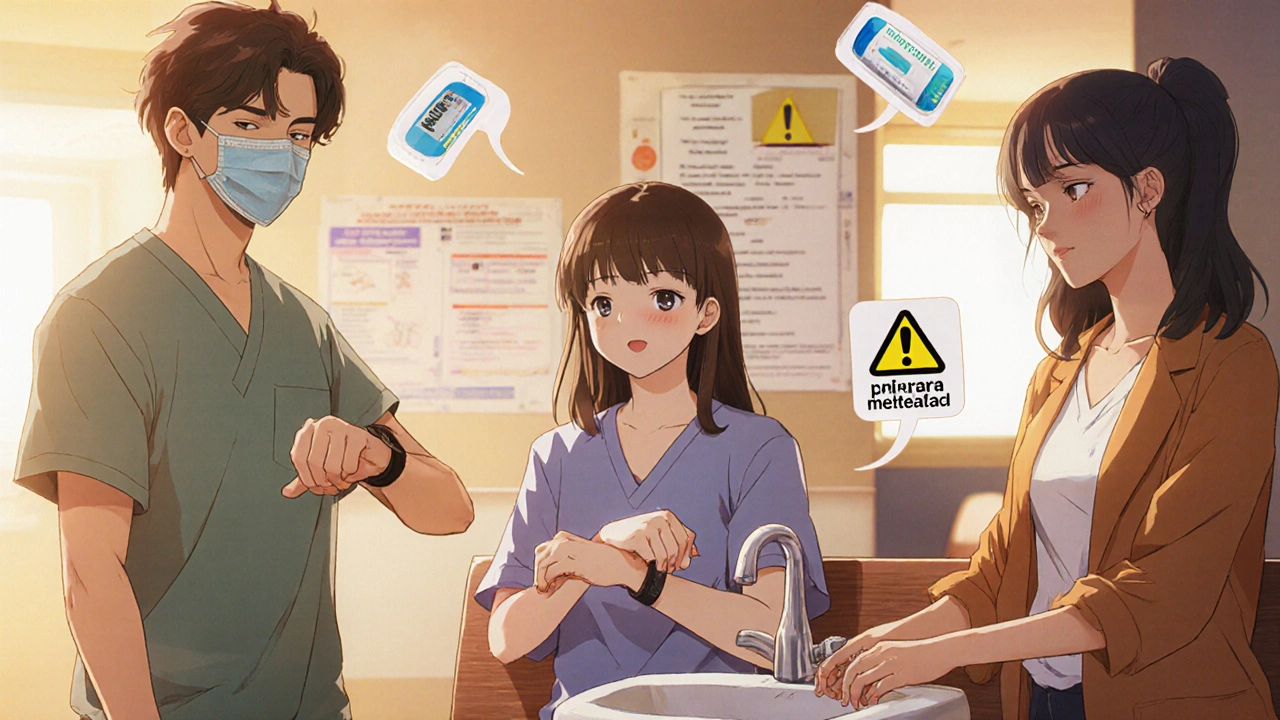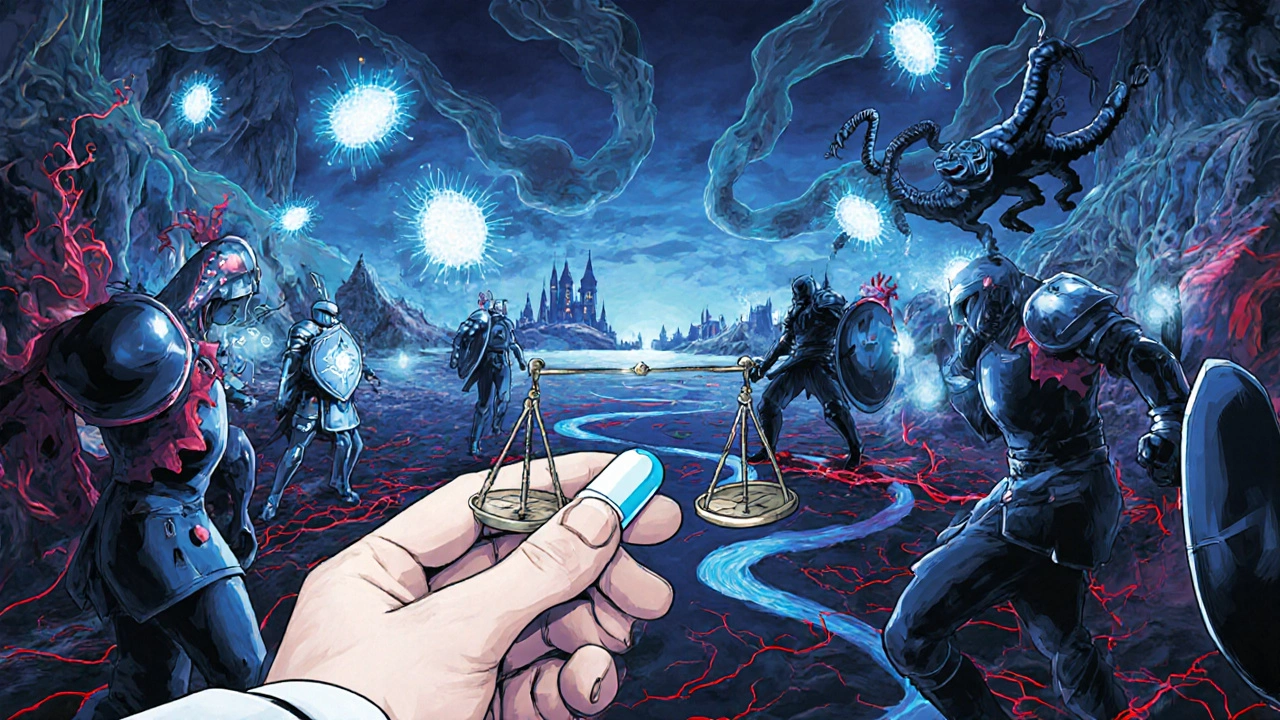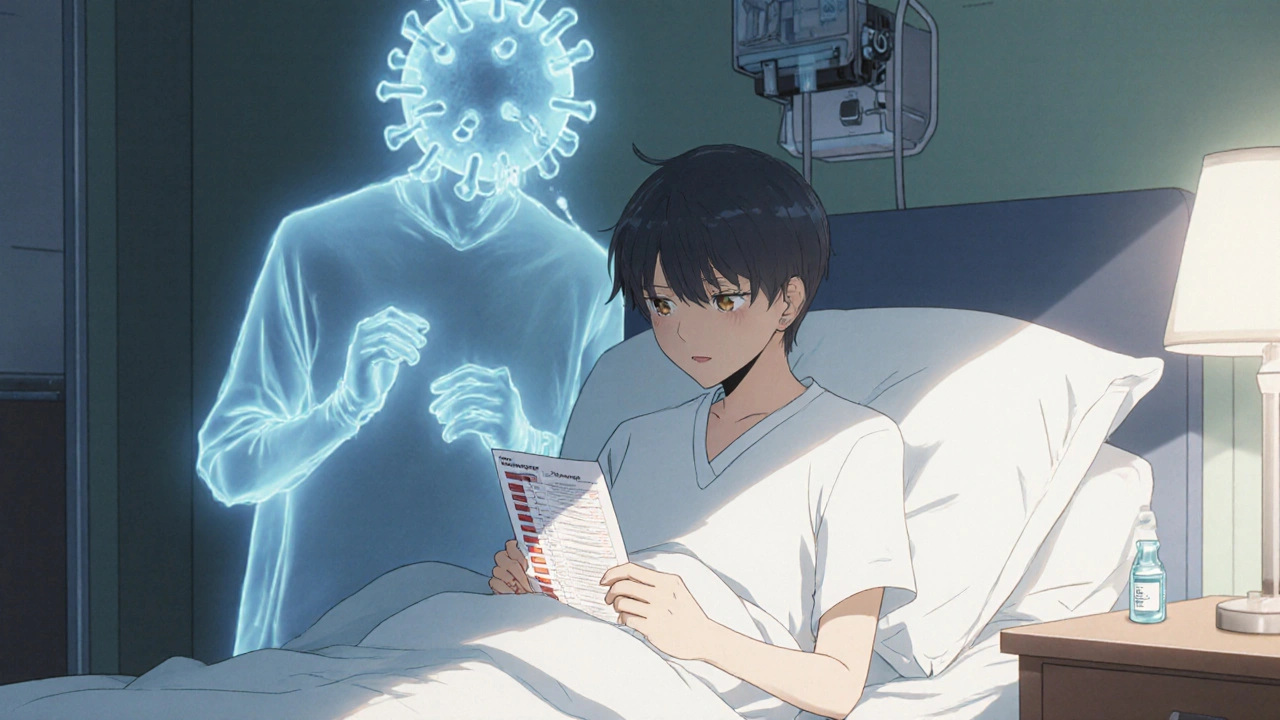Immunosuppressant Risk Calculator
Assess Your Medication Risk
Enter your medication details to understand your infection risk level and learn about specific precautions to take.
When your immune system is weakened-whether from cancer treatment, an organ transplant, or an autoimmune disease like rheumatoid arthritis or lupus-taking medication becomes a high-stakes game. The drugs that keep you alive or relieve pain can also make you dangerously vulnerable to infections you’d normally shrug off. For immunocompromised patients, a simple cold can turn into pneumonia. A minor cut can lead to a life-threatening bacterial infection. And sometimes, the signs of infection don’t look like infection at all.
What Does It Mean to Be Immunocompromised?
Being immunocompromised means your body’s defense system isn’t working the way it should. You might not get sick more often than others, but when you do, it hits harder and lasts longer. This isn’t just about having a cold that won’t go away. It’s about your body losing the ability to fight off bacteria, viruses, fungi, and even dormant viruses like herpes zoster (shingles) that have been hiding in your nerves for years. The causes are varied. Some people are born with rare immune disorders. Others develop immunosuppression from chronic illnesses like HIV or diabetes. But the most common reason today? Medication. Drugs like prednisone, methotrexate, azathioprine, and biologics like adalimumab (Humira) or tocilizumab (Actemra) are designed to calm an overactive immune system. That’s great for stopping joint damage or preventing organ rejection. But it also leaves you exposed.The Hidden Danger: Infections That Don’t Look Like Infections
One of the most dangerous things about being on immunosuppressants is how infections hide. Normally, when you’re sick, your body throws up a red flag: fever, chills, swollen lymph nodes, pus, intense fatigue. But corticosteroids like prednisone blunt those signals. A patient on high-dose steroids might have a severe lung infection with no fever at all. Their only symptom? A slight cough and feeling “off” for a week. This isn’t speculation. Research from 2005, cited by the PMC, shows corticosteroids can mask classic infection signs so effectively that doctors miss diagnoses. A 2012 meta-analysis of over 4,000 patients found that those taking corticosteroids had a 60% higher chance of developing an infection compared to those on placebo. And the higher the dose-especially above 20mg of prednisone daily-the worse the risk. For patients on biologics, the threat is even more specific. TNF inhibitors like infliximab (Remicade) are linked to reactivation of tuberculosis and hepatitis B. Some patients develop fungal infections like histoplasmosis after traveling to areas where it’s common, even if they’ve never been there before. Others get Pneumocystis jirovecii pneumonia (PCP), a rare lung infection that rarely affects healthy people.How Different Medications Change the Risk
Not all immunosuppressants are the same. Each class carries its own set of risks:- Corticosteroids (prednisone, methylprednisolone): The most common. Risk rises sharply after two weeks of use and above 20mg/day. They suppress broad immune responses, making you vulnerable to almost any infection.
- Methotrexate: Used for arthritis and some cancers. Causes fatigue, nausea, and liver stress. About half of users stop taking it within a year because of side effects-but nearly 70% say it controls their disease well. Monthly blood tests are non-negotiable to catch liver or bone marrow damage early.
- Azathioprine: Reduces white blood cells. Leukopenia is the big red flag. Patients on this drug are at higher risk for bacterial infections, especially during low-count periods, and for viral reactivations like CMV or JC virus (which can cause PML, a rare but fatal brain disease).
- Biologics (Humira, Enbrel, Remicade): Target specific immune pathways. They’re powerful but come with the highest infection risk of any class. Studies show they’re significantly more likely to cause serious infections than older DMARDs. Herpes zoster reactivation is common-some patients get shingles within months of starting treatment.
- Calcineurin inhibitors (tacrolimus, cyclosporine): Used after transplants. Increase risk of Epstein-Barr virus (linked to lymphoma), hepatitis C flare-ups, and polyomavirus infections that can damage kidneys.
- Chemotherapy drugs (cyclophosphamide, paclitaxel): These aren’t just for cancer. Used in severe autoimmune cases, they wipe out immune cells like a sledgehammer. Infection risk here is among the highest of all treatments.
Combining drugs multiplies the danger. A patient on both prednisone and methotrexate isn’t just at double the risk-they’re at exponentially higher risk. That’s why doctors try to use the lowest effective dose for the shortest time possible.

What Patients Are Really Experiencing
Online forums like Reddit’s r/RheumatoidArthritis and r/Transplant are full of raw stories. One user described getting shingles at 32 after starting Humira. Another, post-kidney transplant, said tacrolimus was “life-changing” but required constant vigilance: no gardening without gloves, no raw sushi, no crowds during flu season. Many report fatigue within hours of taking methotrexate. Others lose hair, get mouth sores, or can’t sleep. But they keep taking it because the alternative-uncontrolled inflammation-is worse. One woman said, “I’d rather be tired and alive than in constant pain and in a wheelchair.” But the real danger isn’t just the drugs. It’s underestimating the risk. Patients often think, “I’ve been on this for years, I’m fine.” Then, they skip a blood test. They ignore a low-grade fever because they’re “used to feeling off.” Or they travel to a tropical country and get bitten by a mosquito-something the CDC specifically warns immunocompromised people to avoid. Dengue, Zika, or even West Nile virus can become deadly when your immune system can’t respond.How to Protect Yourself
There’s no magic shield, but there are proven steps that save lives:- Wash your hands for 20 seconds-long enough to sing “Happy Birthday” twice. Pay attention to under nails and between fingers. Use alcohol-based sanitizer when soap isn’t available.
- Get vaccinated before starting treatment. Live vaccines (like MMR, varicella, nasal flu) are off-limits once you’re immunosuppressed. But flu shots, pneumonia vaccines, and COVID boosters are critical-even if they’re less effective in you, they still reduce severity.
- Wear a mask in crowded places, especially during cold and flu season. Hospitals and public transit are high-risk zones.
- Practice smart wound care. Even a paper cut can become infected. Clean it immediately and use antibiotic ointment if advised.
- Know your warning signs. If you feel unusually tired, have a persistent cough, unexplained fever (even 99.5°F), night sweats, or a rash that won’t go away-call your doctor. Don’t wait.
- Get regular blood work. CBC, liver and kidney tests aren’t optional. They’re your early warning system.
Some patients are told to avoid raw foods-no sushi, rare steak, unpasteurized cheese. That’s not fear-mongering. Listeria and E. coli can be fatal to someone with a suppressed immune system.
It’s Not All Doom and Gloom
A major study from Johns Hopkins in 2021 surprised the medical world. Researchers expected immunocompromised patients to have far worse outcomes with COVID-19. Instead, their outcomes were similar to those of people with healthy immune systems. Why? Maybe because the drugs that suppress inflammation also calm the dangerous cytokine storms that kill people from severe COVID. This doesn’t mean you’re safe. But it does mean that blanket assumptions about immunosuppression and infection risk are outdated. Your risk depends on your specific drugs, your dose, your age, your other health conditions, and how closely you’re monitored. The future is moving toward personalized dosing. Researchers are studying how genetics affect how you metabolize methotrexate or azathioprine. Soon, blood tests might tell your doctor exactly how much immune suppression you’re experiencing-not just guess based on weight or diagnosis.
What You Should Ask Your Doctor
Don’t wait for your doctor to bring this up. Be proactive:- “What specific infections am I most at risk for with this medication?”
- “Are my vaccines up to date? Which ones should I get before starting?”
- “What blood tests do I need, and how often?”
- “If I get sick, when should I call you instead of waiting?”
- “Are there alternatives with lower infection risk?”
Doctors aren’t mind readers. If you don’t ask, they might assume you know the risks-or that you’re okay with them.
The Bigger Picture
About 24 million Americans have autoimmune diseases. That’s 7.6% of the population. And the number is rising. As more people live longer with these conditions thanks to better drugs, managing the trade-offs becomes a lifelong skill. The FDA requires black box warnings on many immunosuppressants for serious infections and cancer risk. That’s not just paperwork-it’s a signal that these drugs demand respect. The real win isn’t just surviving. It’s living well. Many patients on immunosuppressants go back to work, travel, play with their grandchildren, and live full lives. But they do it with awareness. With routine. With discipline. It’s not about being scared. It’s about being smart.Can immunosuppressants cause cancer?
Yes, some immunosuppressants increase cancer risk, especially skin cancer and lymphoma. Long-term use of drugs like azathioprine and cyclosporine is linked to higher rates of non-melanoma skin cancer and post-transplant lymphoproliferative disorder (PTLD). Regular skin checks and avoiding UV exposure are critical. The risk is real but manageable with monitoring.
Can I get the flu shot if I’m immunocompromised?
Yes, but only the inactivated (non-live) flu shot. Avoid the nasal spray vaccine, which contains live virus. Even though the vaccine may not work as well in your body, it still lowers your chance of severe illness, hospitalization, or death. Get it every year.
Why do I need blood tests every month if I feel fine?
Many side effects of immunosuppressants-like low white blood cell counts or liver damage-don’t cause symptoms until they’re advanced. A CBC test can catch dangerous drops in your immune cells before you get sick. Monthly tests during the first few months of treatment are standard for drugs like methotrexate. Skipping them is like driving without checking your oil light.
Is it safe to travel while on immunosuppressants?
Travel is possible, but requires planning. Avoid areas with high rates of tuberculosis, malaria, or dengue. Get travel-specific vaccines before starting treatment. Carry a letter from your doctor listing your medications. Bring extra doses. Avoid raw food, untreated water, and crowded places. Talk to your doctor at least 6 weeks before traveling.
What should I do if I think I have an infection?
Don’t wait. Call your doctor immediately-even if you don’t have a fever. Symptoms like fatigue, cough, diarrhea, skin rash, or feeling generally unwell for more than 48 hours could signal something serious. Don’t take over-the-counter fever reducers to mask symptoms. Your doctor needs to see the real picture.
Can I ever stop taking immunosuppressants?
Sometimes, yes-but never without medical supervision. In some autoimmune diseases, patients achieve remission and can slowly taper off under close monitoring. For transplant patients, stopping means risking organ rejection. For others, the disease will flare badly without the drug. Your doctor will assess your condition, lab results, and risk level before making any changes.


Comments
james lucas
man i just started methotrexate last month and holy crap the fatigue is real like i nap after brushing my teeth now but hey at least i can walk to the fridge without crying so i guess its worth it
Mark Williams
From a pharmacokinetic standpoint, the variable CYP3A4 and TPMT polymorphisms significantly modulate metabolite clearance rates for thiopurines and antimetabolites respectively. The clinical implication is that standard dosing protocols may grossly under- or over-suppress immune function in genetically distinct subpopulations. Pharmacogenomic-guided titration is not just ideal-it's becoming the standard of care in tertiary centers.
Jessica Correa
i just want to say thank you to everyone who shared their stories here i feel less alone now i thought i was the only one who got scared every time i sneeze
Ravi Kumar Gupta
Bro in India we dont even have access to biologics properly and doctors still give prednisone like candy my cousin got steroid psychosis at 28 and no one cared just said take more steroids its fine
Rahul Kanakarajan
Why are people still on methotrexate when azathioprine has lower infection risk and is cheaper? This is basic pharmacology 101. You're all being manipulated by Big Pharma marketing. Stop being sheep.
manish chaturvedi
As someone who has managed immunosuppression for over a decade, I can confirm that regular CBC monitoring and avoiding raw foods are non-negotiable. In my community, many patients delay care due to stigma or financial constraints. Education and access must improve. Small steps matter.
Miruna Alexandru
It's fascinating how society romanticizes "living well" with chronic illness while ignoring the systemic failures that make this a daily negotiation of survival. The real tragedy isn't the medication-it's that we've normalized requiring superhuman discipline just to avoid dying from a paper cut.
Daniel Jean-Baptiste
got my flu shot last week and my arm still hurts but i dont care i'd rather have a sore arm than end up in the hospital again
Holly Schumacher
Did you all read the 2021 Johns Hopkins study? The one that "surprised" everyone? Funny how they ignored the fact that most of these patients were on TNF inhibitors which suppress cytokine storms. That's not a win-it's a dangerous coincidence. You're not immune to COVID because you're immunocompromised-you're just lucky your drugs accidentally saved you. Don't mistake luck for safety.
Michael Fitzpatrick
just wanted to say to anyone feeling overwhelmed right now-you’re doing better than you think. i was scared to leave the house for a year after my transplant but now i go to the park with my kids and even hug my mom again. it’s not perfect but it’s mine and that’s enough
Shawn Daughhetee
my doc told me to avoid sushi and raw eggs but i still eat rare steak once a week i know its risky but i miss food